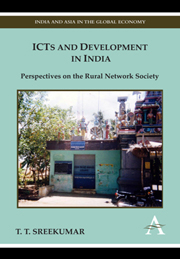Book contents
- Frontmatter
- Contents
- List of Figures and Tables
- Preface
- 1 Introduction: Exploring the Rural Network Society
- 2 Civil Society and Cyber–Libertarian Developmentalism
- 3 Decrypting E-Governance
- 4 Cyber-Kiosks and Dilemmas of Social Inclusion
- 5 Innovating for the Rural Network Society
- 6 ICT and Development: Critical Issues
- Notes
- Bibliography
- Index
1 - Introduction: Exploring the Rural Network Society
Published online by Cambridge University Press: 05 March 2012
- Frontmatter
- Contents
- List of Figures and Tables
- Preface
- 1 Introduction: Exploring the Rural Network Society
- 2 Civil Society and Cyber–Libertarian Developmentalism
- 3 Decrypting E-Governance
- 4 Cyber-Kiosks and Dilemmas of Social Inclusion
- 5 Innovating for the Rural Network Society
- 6 ICT and Development: Critical Issues
- Notes
- Bibliography
- Index
Summary
Two Rural Vignettes and the Beginning of a Story
The following introductory paragraphs appeared in an article published in the Canadian Journal of Educational Communication in 1987:
In the small Swedish village of Vemdalen, the visitor can witness an unexpected sight. On the first floor of the building containing the local general store, a considerable number of modem computers and other equipment are being used diligently by local people from eight o'clock in the morning until ten o'clock in the evening. The equipment is worth a closer look: PC ATs, 15 personal computers from the United States and Japan, word processors and teletexts from Holland, Telefax, Videotex; in short, lots of high technology in the heart of a sparsely populated mountainous part of Sweden (Vemdalen today boasts having more computers per capita than any other part of Sweden).
The first Scandinavian telecottage, Härjedalens Telestuga, was opened here on 13 September 1985, and shortly after its inception, all this equipment was being used by 15 per cent of the people in the village, with everyone from 10-year-old children to pensioners represented. The funds for establishing the telecottage came from the County Government Board as part of a project for the propagation of modern technology in sparsely populated areas, Swedish Telecom and the municipal board. […]
- Type
- Chapter
- Information
- ICTs and Development in IndiaPerspectives on the Rural Network Society, pp. 1 - 32Publisher: Anthem PressPrint publication year: 2011



